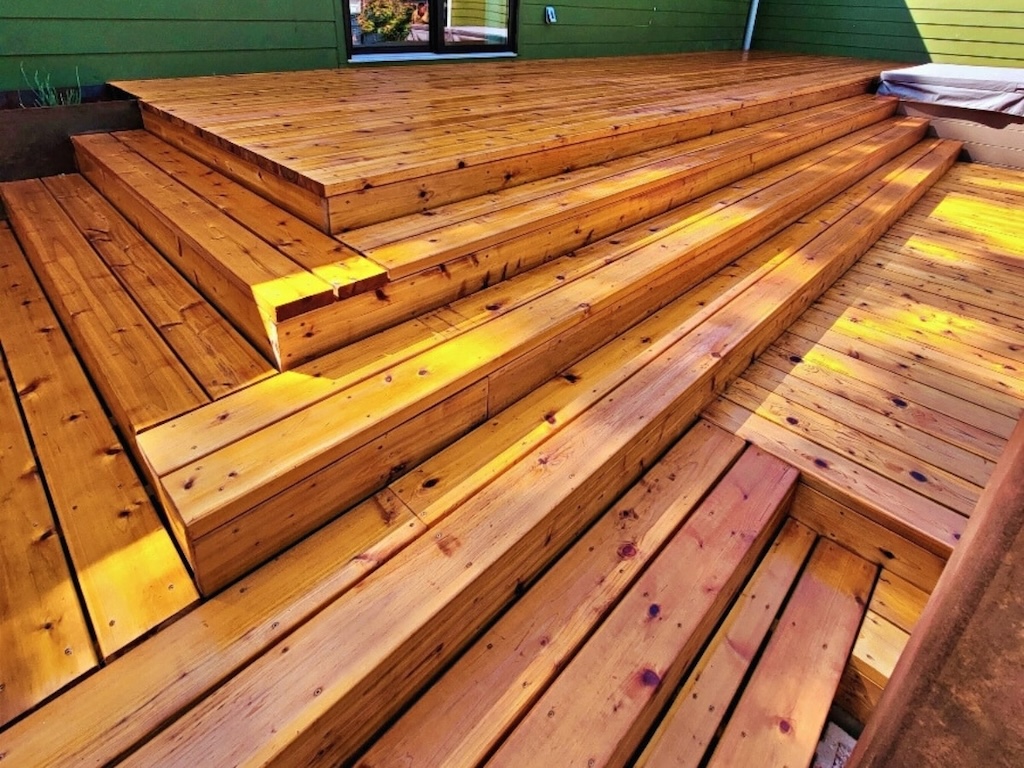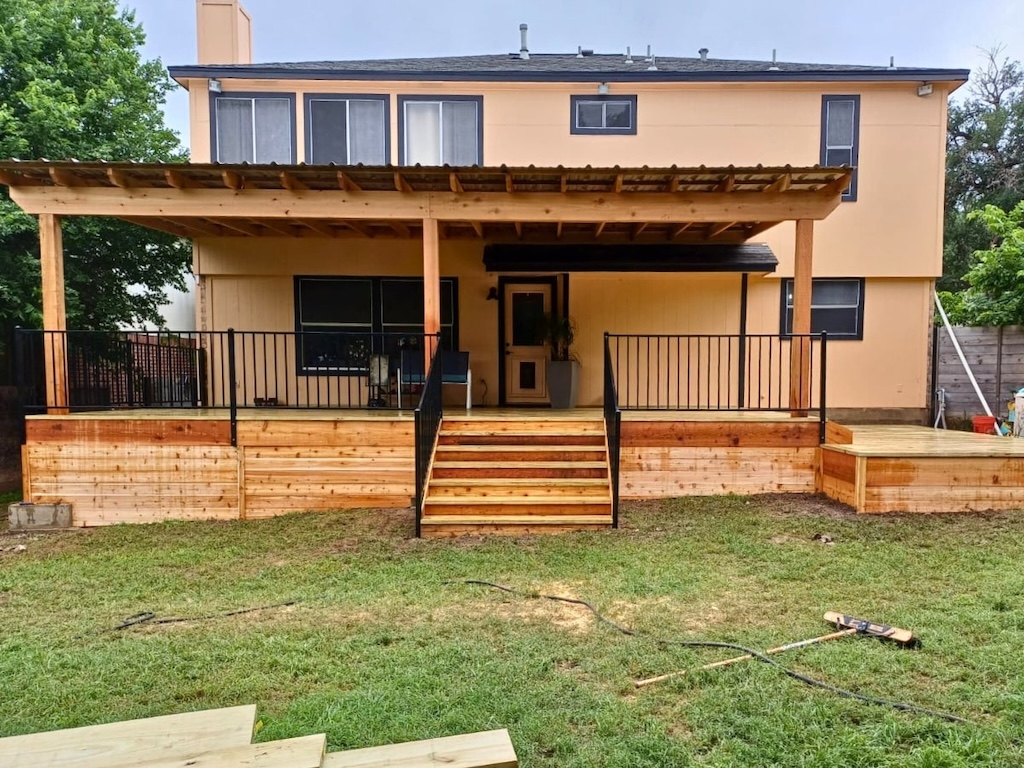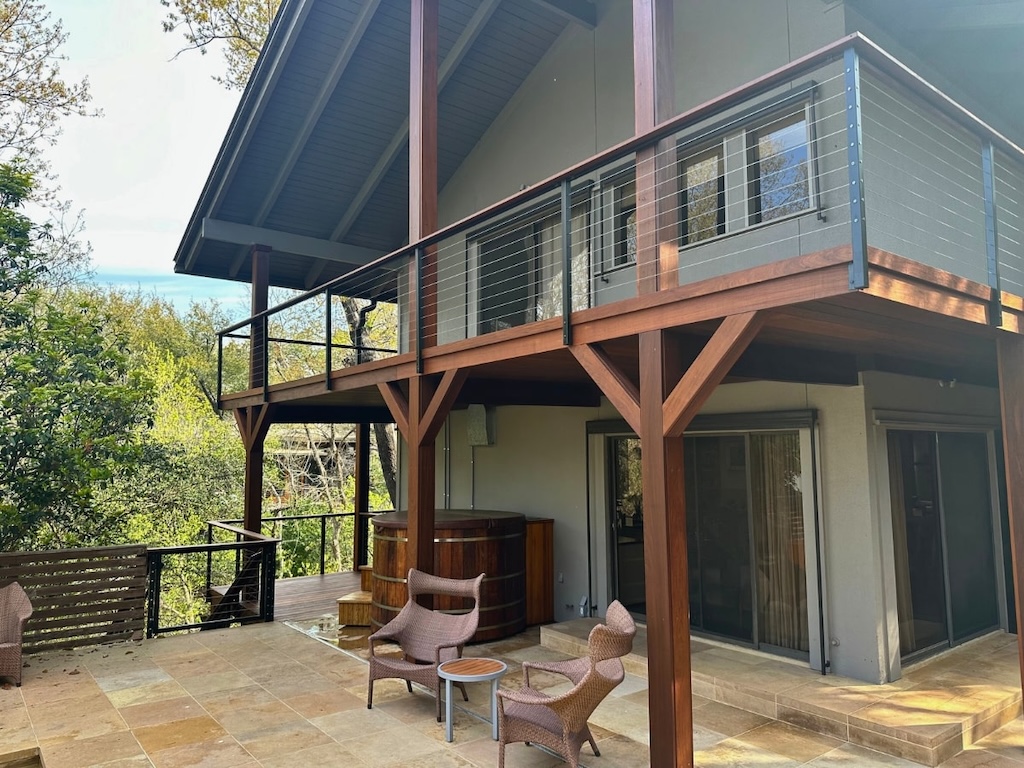TL;DR
For most Austin homes, a straightforward, single-level deck of ~300–400 sq. ft. takes 2–4 weeks of on-site work once permits are approved and materials are on site. The whole project timeline (from first consult to final walkthrough) typically spans 4–10 weeks, depending on design decisions, permitting queues, inspections, weather, and material/crew availability. Multi-level layouts, custom railings, integrated lighting/gas, or complex site conditions can extend this window. The best way to stay on time is to pick a specialist, approve drawings quickly, and follow a schedule that builds around inspection “hold points.” To see the kind of process and craftsmanship you should expect from deck builders in Austin, skim the project standards on Ace Deck Builders.
Table of Contents
ToggleWhy Austin Timelines Vary

Even “simple” decks run through multiple decision and approval gates. In Central Texas, a realistic schedule accounts for:
- Design decisions (layout, stairs, railing system, shade features, lighting): making faster decisions leads to faster procurement.
- Permitting (and HOA approvals if applicable): submittal completeness and reviewer feedback can add days to weeks.
- Inspection sequencing: decks usually have at least footing, framing, and final inspections; missing prep at any step can trigger delays.
- Climate: heat, sudden storms, and transparent windows for stains/sealants determine when specific tasks can be performed.
- Material lead times: popular composite lines, specialty railings, and custom metal details may require extra lead time.
- Crew availability & staging: the difference between “crew on site daily” and “crew juggling multiple jobs” is often the difference between a smooth 2–3 week build and calendar creep.
The Full Journey: From First Call to Final Walkthrough
Below is a realistic, step-by-step outline. Times are typical ranges—your actual schedule depends on complexity and approvals.
1) Discovery & Initial Estimate (1–7 days)
A quick conversation and site review clarify goals for your outdoor space: size, elevation, stairs, railings, material preferences, and must-have features (privacy, shade, kitchen). A ballpark estimate follows to ensure budget alignment. Early clarity here shortens the rest of the process.
2) Design & Proposal (3–14 days)
A serious builder documents a plan set (layout, elevations, stair geometry, railing notes) and provides an itemized proposal listing framing species, decking material brand/series, railing system, lighting count, skirting, fascia, and allowances for unknowns (e.g., rock excavation). Rapid feedback on these documents is the #1 lever you control to keep momentum.
3) HOA & City Submittals (5–20+ days)
Where required, HOA review often runs in weekly cycles. City reviewers focus on structural clarity: footing sizes/depths, ledger details, spans/joist spacing, and railing post connections. Clean drawings and a responsive contractor ensure faster approvals, especially when revisions are requested, as turnaround speed is crucial.
Do you want a deeper breakdown of the process, including drawings, submittals, and inspection sequencing? Mid-research, it helps to benchmark professionalism against a specialist’s overview of deck installation in Austin and see which steps they own versus which require your sign-off.
4) Procurement & Scheduling (3–10 days)
After approvals, materials are ordered, and a start date is slotted. Composite boards, matching fascia, rail kits, and lighting components must line up to avoid mid-build gaps. Competent builders schedule footing inspections early in the first build week and pencil in framing inspections based on progress.
5) On-Site Work & Inspections (2–4+ weeks)
This phase is where homeowners “feel” the project happening.
- Mobilization & Layout (Day 1–2): site protection, layout lines, footing marks.
- Footings (Day 2–5): dig, set forms, and call for footing inspection. Pass means pour; fail means quick fixes.
- Framing (Week 2): beams, joists, blocking, ledger flashing—then framing inspection.
- Decking & Railings (Week 2–3): lay decking, install rails/posts, address stairs and landings.
- Finishes & Punch (Week 3–4): skirting, fascia, lighting trim, cleanup, and final inspection.
6) Closeout & Care (1–3 days)
Walk the space together, create a punch list, and finalize details. You’ll receive a care packet containing a cleaning/stain schedule for wood, warranty contacts, and any as-built notes that matter for future service or add-ons.
Not every aging deck needs a complete rebuild. If your structure is sound but tired, a focused tune-up can save money and time. A quick primer on deck repair in Austin explains when targeted fixes beat replacement—and when safety or cost tips the decision.
For hour-by-hour transparency during the build, check out this homeowner-friendly walkthrough, which explains what to expect during a deck installation and how inspections and punch lists are handled to avoid schedule drama.
Typical Durations by Project Type

While every site is unique, these ranges help set expectations once approvals are in hand and materials are ready:
- Simple single-level deck (~300–400 sq. ft., wood or entry-level composite): 2–3 weeks on site.
- Single-level with custom railing, integrated lighting, or privacy screen: 3–4 weeks.
- Multi-level deck with multiple stair runs: 3–5 weeks.
- Rooftop or elevated decks with engineered details: 4–6+ weeks (design/engineering adds time upstream).
- Pool-adjacent decks with specialty fasteners and slip-aware surfacing: 3–5 weeks (weather windows matter more here).
Remember: these are on-site durations. Design, HOA, permitting, and procurement add time before mobilization.
What Speeds Projects Up (and What Slows Them Down)
Speed-Up Factors
- Approve drawings fast. Every round trip adds days. Batch feedback; decide quickly.
- Pick in-stock materials. Selecting hot SKUs with long lead times can drag schedules.
- Aim for mid-week inspections. Submitting early improves your place in the lineup.
- Keep the scope focused. Each “one small add-on” (extra landing, lighting change, screen wall) has a ripple effect on the plan, materials, and inspection order.
Slow-Down Factors
- Scope drift after procurement.
- Unclear site access (locked gates, pets loose, vehicles blocking work area).
- Hidden conditions (rocky soils, buried roots, unforeseen rot).
- Weather (rain, wet soils, or extreme heat that limits adhesive or finish work).
- Inspection rework (if connections aren’t exposed or details don’t match drawings).
The “Hold Points” That Make or Break Your Schedule
Think of inspections as gates you must pass to move forward:
- Footings: Holes must be open and clean; the inspector sees depth, bell, and soil conditions. Only then is concrete green-lit.
- Framing: Ledger flashing, fastener patterns, joist spans, and post connections must be visible. No decking should cover these yet.
- Final: Rail heights, stair code, electrical trim, and overall safety details are checked.
A builder who preps sites for inspectors—exposed connections, clean footing holes, labeled details—saves days of back-and-forth.
Owner To-Dos That Keep Things Moving
Homeowners have real leverage over the schedule. The smoother you handle your part, the faster the crew can keep momentum:
- Selections locked (decking color/line, railing style, lighting finishes) before procurement.
- Access coordinated (gates unlocked, vehicles moved, pets safe).
- HOA responses are batched instead of piecemeal.
- Quick sign-offs on plan revisions or substitution requests (e.g., rail kit back-order).
- Contingency approvals for reasonable footing changes if rock or roots appear.
Weather, Heat, and Finish Windows in Central Texas

Austin brings intense sun, sudden showers, and long hot spells. Timelines must respect:
- Cure and finish windows for stains/sealants (wood projects) and adhesives.
- Heat exposure limits for crews and materials necessitate shifting some tasks earlier or later in the day to ensure safety and quality.
- Storm prep for partially framed decks—temporary bracing and weather protection keep the schedule safe.
If a heat wave or rain band hits, a good builder will resequence tasks to keep things moving (e.g., rough electrical pre-wire while waiting for the right finish window).
Budget & Scheduling: How to Protect Both
Time and money travel together. Keep both on track with:
- Itemized estimates (labor + materials + allowances) so you can see where time is spent.
- Milestone billing is tied to progress, including permit approval, material delivery, inspection pass, and substantial completion.
- Defined change-order process (in writing) that pauses work until you approve the price and timeline impact.
- Weekly updates from your project lead—“no change” updates still matter, because they flag risks early.
FAQs
A minimal, single-level layout with basic railings can often be finished in about two weeks of on-site work, assuming clean inspection passes and no weather delays.
Design indecision and inspection rework. Decide quickly on drawings and expose details for inspectors—those two steps save the most days.
Yes. In-stock composites and standard railing kits keep momentum. Custom metals, specialty lighting, and back-ordered boards can add 1–3+ weeks before you even start.
There isn’t a single “magic” month, but avoiding the heaviest booking peaks and planning around finish windows helps. Heat/UV also influences comfort and product selection.
For wood decks, including pressure-treated wood, plan on prep, dry, application, and cure windows. Depending on weather and product, that can add 2–5 days around the main build (often scheduled at the end).
Get Your Austin Deck Finished On Time
For a dependable schedule with clear inspection milestones, itemized pricing, and realistic finish windows, including custom features, begin with a free deck estimate in Austin. We’ll map your design, permitting path, inspection hold points, and a week-by-week plan to get you from layout lines to the first backyard cookout—without surprises.
